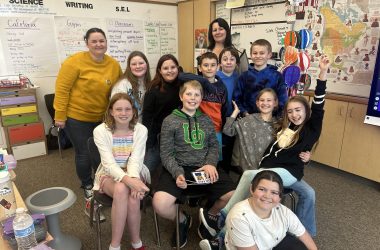 The Main Street Program in Cottage Grove has lined its Historic Downtown utility poles with personalized sentiments from residents for Valentine’s Day. Dana Merryday/The Chronicle
The Main Street Program in Cottage Grove has lined its Historic Downtown utility poles with personalized sentiments from residents for Valentine’s Day. Dana Merryday/The Chronicle
With Valentine’s Day being tomorrow it seems appropriate to mention the latest addition to Cottage Grove’s historic downtown. ”Hearts on Main” is a beautification program sponsored by the Main Street Program that has lined the main drag with bright red hearts with bold white messages.
The words emblazoned on the two-sided hearts range from the deeply personal to the generic. My favorite was the simple prescription, ”Everybody Love Everybody.”
I think if we could pull that off, all else would follow!
It was nice to stroll up and down the street looking for the hearts that were attached to utility poles courtesy of Pacific Power. Folks who sponsored the hearts had a choice of a single side or both sides for the message to continue or even have a completely different one on the back.
Sponsors will also have the right of first refusal to have their heart up again next year or to change the message to a different sentiment for 2021.
If you want to get into the spirit of the heartfelt message movement, watch for next year’s announcement of the ”Hearts on Main” program.
The hearts went up Feb. 4, and will remain smiling down on us until Feb. 21. Besides brightening the grey days of February, the ”Hearts on Main” are serving as a fundraiser for the Main Street Program to pay for future activities and events.
If you haven’t made plans for a romantic evening with your beloved, maybe a leisurely walk down Main Street to take in the hearts – followed by a visit to one of our fine downtown dining or drinking establishments – would be in order.
Another suggestion for Valentine’s Day is participating in the Great Backyard Bird Count (GBBC). This important worldwide data collection has more than 160,000 observers participating in this online citizen-science project. The count runs Feb. 14-17.
I remember hearing a story in Sunday School about St. Valentine, while in prison awaiting his martyrdom, sending a message on a heart-shaped leaf via a bird to the daughter of his jailor whom he had cured of blindness. While the tale is probably apocryphal it is the basis of the tradition that is repeated by our giving of Valentine cards – many of which show a bird (usually a dove) delivering the card in its beak.
You can do the bird count several ways. If you have at least 15 minutes to observe these beauties flitting about in search of sustenance, then you can be an individual reporter.
If you like birding with a group, then you are also in luck. The Coast Fork Birders are meeting at 8 a.m. on Saturday, Feb. 15 at the Row River Nature Park. This is the 8th annual GBBC that the Coast Fork group has sponsored at the Nature Park, also known as the Turtle Ponds.
Julie Parker will be guiding the group and she recommends wearing weather-appropriate clothing, good footwear (the walk will be on paved and unpaved terrain), binoculars, bird book, and your own snacks and water. Please leave your four-legged friends at home.
So what is the point in counting birds? Well, the GBBC was put together in 1998 by the Cornell Lab of Ornithology and the National Audubon Society. This large collaboration between scientists and citizen volunteers was the first to utilize the internet and to display the results in near-real time.
In 2013 the groups merged with eBird, the online checklist service that allowed birders to share information and sightings worldwide.
Bird populations are dynamic and constantly in flux. It would be impossible for any single team of scientists to follow or document the complex distribution and movements of so many bird species at any given time.
Scientists can use the data collected by the GBBC and other such observations such as the Christmas Bird Count and Project Feeder Watch to try to get the ”big picture” of what is happening with bird populations.
The count is held in February because the birds haven’t started their big spring migration that generally takes place in March. The data collected over the years can show if a species’ range is expanding or contracting. If an especially large change is noted, it’s a sign that something is going on with the environment and deserves further investigation.
As the climate changes and species have to adapt or move into new ranges to find food, the GBBC and other citizen-monitoring data will be valuable in trying to understand what is happening to our feathered friends.
To participate, go to the website gbbc.birdcount.org/. If you don’t have an eBird account you will be guided through the signup process. Then you can join participants in more than 100 countries, who last year reported more than 6,800 species on over 200,000 checklists.
You can observe from anywhere. Your own back or front yard, a park, forest, waterway, wildlife preserve or field. All you need is at least 15 minutes of watching and then to record your checklist. You can submit multiple checklists over the four days of the bird count and vary your viewing area or the time of day you observe.
I know from my own backyard that the bird activity at the feeders goes from the frantic frenzies with near midair collisions to hardly a bird to be seen during the course of any given day. They seem to have their times when they must go elsewhere. (My neighbor always said the Juncos would go to Cerro Gordo).
Well, here is wishing you and your beloved a very happy Valentine’s Day – just tell them a little bird told you so!
Contact Dana at 541-942-7037 or [email protected].








